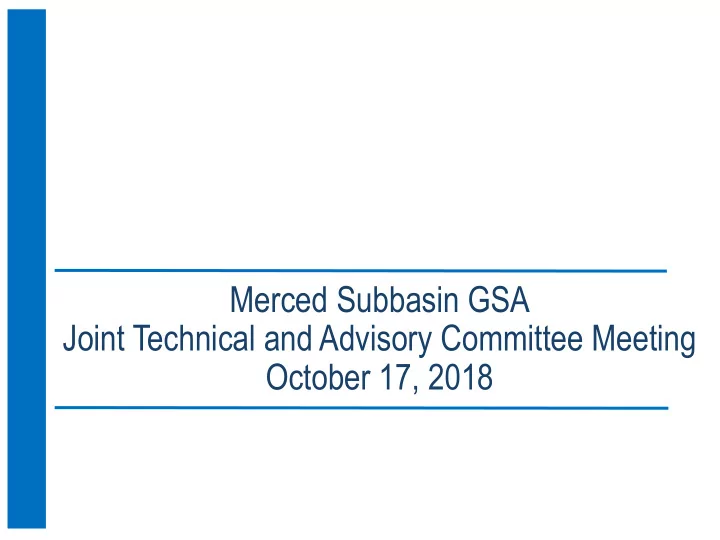

Merced Subbasin GSA Joint Technical and Advisory Committee Meeting October 17, 2018
Overall Objective: Develop Measurable Objectives for Each Sustainability Indicator Storage Chronic Lowering of Groundwater Levels addressed by bringing budget into balance Reduction in Groundwater Storage Seawater Intrusion Salinity Addressed Degraded Water Quality Under Water Quality Land Subsidence Depletion of Interconnected Surface Water
Process for Defining Measurable Objectives Begins with Identifying Undesirable Results These objectives, and the pathway to achieving them (projects, management actions, etc ), are the “guts” of the GSP Document Potential Identify “Minimum Develop “Measurable Undesirable Results Thresholds” (Levels Objectives” Above for Each Sustainability Where Undesirable Each Minimum Indicator Results Could Occur) Threshold We start by thinking about what our desired future condition looks like, and what negative impacts we are trying to avoid.
Undesirable Results “Significant and Unreasonable” negative impacts that can occur for each Sustainability Indicator Conditions that we do not want to occur Used to guide and justify GSP components Monitoring Network Minimum Threshold Projects and Management Actions
Example: Groundwater Levels Groundwater Elevation Time in Years
Brainstorming: What Undesirable Results Are We Trying to Avoid? Chronic Lowering of Groundwater Levels Chronic Lowering of Groundwater Levels Reduction in Groundwater Storage Reduction in Groundwater Storage Seawater Intrusion Seawater Intrusion Degraded Water Quality Degraded Water Quality Land Subsidence Land Subsidence Depletion of Interconnected Surface Water Depletion of Interconnected Surface Water
Undesirable Results – Comments from Stakeholder Committee Groundwater Elevation Degraded Water Quality 1. Cost of pumping water 1. Human consumption 2. Harder to recharge (with decline in 2. Reduced crop yields levels) 3. Soil impacts 3. Energy requirements increasing 4. Public health + sanitation 4. Shallow wells going dry 5. Well replacement costs 6. Decline in yields Subsidence Interconnected Surface Water 1. SED impacts 1. Loss of storage 2. Infrastructure impacts 2. Environmental quality + habitat 3. Irreversible system impacts 4. Flood flow impacts 5. Planned projects impacts
Minimum Thresholds
Minimum Thresholds Need to be Developed for All Six Sustainability Indicators Chronic Lowering of Groundwater Levels Reduction in Groundwater Storage Seawater Intrusion Degraded Water Quality Land Subsidence Depletion of Interconnected Surface Water
Developing Minimum Thresholds is an Iterative Process Projects and Management Actions Undesirable Minimum Measurable Sustainability Results Thresholds Objectives Water Budget
Minimum Thresholds Thresholds are required at each monitoring location Thresholds defined using the same methodology for all 3 principal aquifers: Outside Corcoran Above Corcoran Below Corcoran
Minimum Thresholds – Updated Approach Added 18 monitoring wells for threshold analysis Merced County domestic wells database Active wells Omits wells that do not meet County annular seal requirement Filtered for other outliers Minimum threshold is defined as the shallowest of either Historical low groundwater elevation at the monitoring well, minus a buffer (range of min & max GWLs from 2008-2018) – this assumes that over the next 20 years, GWE will decline at approximately half the max rate seen over the past 10 years UNLESS this would dewater the shallowest nearby domestic well – in this case, threshold was increased to protect nearby wells
Voluntary Wells Added
Minimum Thresholds Example: Well 31916 Well 11
Minimum Thresholds Example: Well 31916 Example: Buffer
Minimum Thresholds Example: Well 31742 Well 11
Minimum Thresholds Example: Well 31742 Example: (Buffer not used)
Minimum Thresholds Example: Well 32342 (new voluntary well) Well 11
Minimum Thresholds Example: Well 32342 (new voluntary well) Example: Buffer
What Comes Next? Projected Water Budget will be used to understand average sustainable pumping rates basin-wide Projects and Management Actions need to be identified to include supply and demand-side measures to achieve sustainability Depending on rate of project implementation, groundwater elevation thresholds may need to be adjusted Preliminary Final Thresholds Thresholds Water Budget
Minimum Thresholds Need to be Developed for All Six Sustainability Indicators Chronic Lowering of Groundwater Levels Reduction in Groundwater Storage Seawater Intrusion Degraded Water Quality Land Subsidence Depletion of Interconnected Surface Water
Minimum Thresholds – Water Quality Several constituents of concern in the basin GSP must focus on a causal nexus between water quality and SGMA groundwater management
Water Quality Constituents of Concern
Salinity Issues Primary Sources of High TDS Water 1. Saline, Connate Water from Marine Sedimentary Rocks Pumping of Wells - a. results in upwelling saline brines Corcoran Clay – b. Naturally impedes high TDS groundwater, but wells perforated create channels for TDS to migrate 2. Migration of poor quality water from west
Minimum Thresholds – Water Quality Thresholds are not appropriate for many constituents Cannot be managed through SGMA Are addressed through other programs (CV-SALTS, ILRP, RWQCB, EPA, others) Plumes (Cal/Federal EPA, Regional Board, DTSC) Nexus exists for migration of low-quality (higher-TDS) water from the west / northwest • Control quality of recharge water
Minimum Thresholds Need to be Developed for All Six Sustainability Indicators Chronic Lowering of Groundwater Levels Reduction in Groundwater Storage Seawater Intrusion Degraded Water Quality Land Subsidence Depletion of Interconnected Surface Water
Minimum Thresholds – Land Subsidence Average Annual Subsidence Rate (feet/year) Dec 2011 – Dec 2017
Next Steps Subsidence thresholds can be defined through Subsidence rates Groundwater elevation as a proxy Recommended approach is groundwater elevation GSAs can actively manage elevations Subsidence rates may already be locked-in, with long-term subsidence due to pre-2015 groundwater elevations Thresholds likely set at levels prior to 1/1/2015 Subsidence rates may be reconsidered for consistency with neighboring subbasins
Minimum Thresholds Need to be Developed for All Six Sustainability Indicators Chronic Lowering of Groundwater Levels Reduction in Groundwater Storage Seawater Intrusion Degraded Water Quality Land Subsidence Depletion of Interconnected Surface Water
Minimum Thresholds – Depletion of Interconnected Surface Water Stream-Aquifer Connectivity Reveals Merced and San Joaquin Rivers as Potentially Affected
Next steps Develop proposed groundwater elevation thresholds Compare to groundwater elevation sustainability indictor thresholds Review with GSAs
Next Meeting
Recommend
More recommend